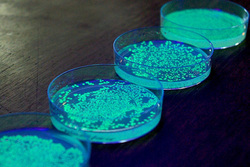The Tale Of Glowing Battalions
Science and miracles have been at a tug-of-war since the beginning of time. In matters of death, miracles are invariably victorious. Nature, however, never fails to astonish mankind.
The battlefield of Shiloh experienced one such scientific miracle. The battle was the bloodiest one in the civil war, with severely injured soldiers lying unattended. Their open wounds erupted blood, putting them at greater risk of infection and bringing them closer to the edge of death. A strange anomaly confused the soldiers, as a few of the wounds gleamed blue in the darkness of the night.
When medical personnel finally arrived more than forty- eight hours later, survivors, physicians, and nurses all described an unsettling blue glow emanating from some of the troops' wounds. Those who cared for these soldiers also noted that they stood a better chance of surviving than the others if they had wounds that lit up. The phenomenon came to be known as “Angel’s Glow.”

The science behind Angel’s Glow was discovered by two curious high schoolers, Bill Martin and Brian Burkhart. After conducting thorough analysis, they came to the conclusion that a bioluminescent bacteria Photorhabdus luminescens could account for the illuminating wounds.
A bacterial insect pathogen from the Enterobacteriaceae family, Photorhabdus luminescens lives symbiotically in the gastrointestinal tract of soil-dwelling nematodes belonging to the genus Heterorhabditis. P. luminescens, is released by regurgitation and invades the hemolymph. Once the germs have entered the insect's bloodstream, the nematode eventually removes the bacteria out. Toxins released by the bacteria kills the host insect and any other microbes it may have contained.
Both the bacteria and the nematode are free to feed, grow, and reproduce until the insect carcass is hollowed from the inside out because no other competing organisms are present. Interestingly, the bacteria are then once again consumed by the nematodes and are now so abundant that they emit a remarkable bluish-green glow.
The glow, according to scientists, is thought to attract additional insects, making it easier for the worm to find its next host.

This brings us to back to the amazement of how these bacteria helped save lives during the civil war. Numerous insects and germs were likely present infesting the open wounds which was the main reason why the injured were ill. The nematodes, entered the soldier's wounds after emerging from the muddy ground.
This time, the bacteria's poison killed all other germs when it was discharged into the bloodstream, preventing the onset of potentially lethal wound infections. The wound would have had the typical bluish-green glow of the bacteria as it continued to grow.
This theory was further confirmed when researchers found the habitat of Shiloh in April, to be suitable for the growth of Photorhabdus Luminescens.
The soldiers had to endure the chilly, muddy, and rainy conditions after fighting off the enemy troops, which led to hypothermia. P. luminescens had been able to develop and glow due to the abnormally low body temperatures!
The bacteria were responsible for the rapid healing of the wounds. According to research already conducted, P. luminescens produces a large amount of the antibiotic 3,5-dihydroxy-4-isopropyl stilbene.
A recent study has identified P. luminescens as a biocontrol agent. Any more bacterial strains nearby can be eliminated by lumicins.
Phyllis Martin has successfully used bioluminescence of these bacteria to combat Colorado potato beetles, a well-known pest of agricultural crops. This has provided us with a new venture into organic farming.
A dive into our history can be the muse of future innovations. Angel’s glow is one captivating enigma, among the millions of miracles our nature is capable of.
References:
https://www.superbugs.online/reading-corner/angels-glow
https://www.thenakedscientists.com/articles/science-features/photorhabdus-luminescens-angels-glow
Lyons, Scott K., Kevin P. Francis, and Christopher H. Contag. "Functional Imaging Using Bioluminescent Reporter Genes in Living Subjects." Molecular Imaging. Academic Press, 2021. 113-141.


